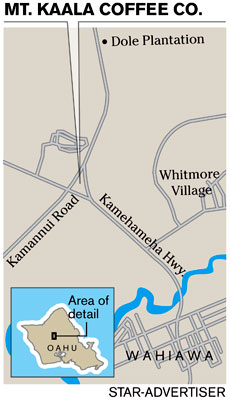Coffee visitor center to offer a cup and tour

A steel-framed structure growing on the former Galbraith Estate lands in Wahiawa where pineapple was once king will soon give rise to a coffee-focused agricultural center.
Green World Farms expects to open its plantation-style 5,000-square-foot Agricultural Visitors Center this fall, providing locals and tourists with a caffeinated pit stop en route to Oahu’s North Shore. Visitors will be able to tour through the entire production process from coffee cherries to harvesting and roasting.
"There are plenty of neighbor island coffee farms and tours, but this will be the first one on Oahu and it will add a lot of value for visitors," said state Tourism Liaison Marsha Wienert "A majority of visitors are still coming to Oahu, so there is a market just waiting to be tapped."
The center sits on a 7-acre triangular tract surrounded by vistas of Oahu’s highest peak, Mount Kaala. It is about three minutes before the Dole Plantation for those heading to the North Shore.
"It’s really the first visitor opportunity after Waikiki for somebody to visit a comfort station on their way to the North Shore," said Honolulu attorney Howard Green, principal investor and financier of the project as well as owner and developer of the North Shore Marketplace, which sits on land owned by Kamehameha Schools.
The center is the result of Green’s partnership with John Alvarez, who is the prime roaster for the North Shore Marketplace’s Coffee Gallery and for several years has wholesaled his own private label, Mt. Kaala Coffee, from Waialua. Alvarez will soon relocate his roasting and wholesaling business to the Galbraith tract, which Green acquired in 2008 and broke ground on about three weeks ago.
Don't miss out on what's happening!
Stay in touch with breaking news, as it happens, conveniently in your email inbox. It's FREE!
The duo planted 100 Waialua coffee trees on two acres of the triangle last year and plan to plant another two or three acres this year. Eventually, they will harvest, roast and market the Mt. Kaala brand from the site, which could be expanded by another 25 acres. At full build-out in about four years, Green said there could be 1,000 coffee trees on the property producing roughly 10,000 to 12,000 pounds of green coffee per year.

In the interim, Green World Farms will process thousands of pounds of coffee from Dole and local farmers. They also will offer those stopping by a chance to sample and buy coffees from throughout the isles.
"We’ll try to carry as many coffees of this island and of the other islands that we can," Green said.
Green and Alvarez are also opening a Mt. Kaala Coffee retail store at the Ilikai Hotel. It will be the brand’s first retail store and in addition to coffee will sell other Wahiawa products.
"We’ll direct them (the Ilikai shop’s customers) to the North Shore," Alvarez said.
Isle agri-tourism has been popular since the plantation era, but in recent times tourism officials and executives have placed new emphasis on forming partnerships with the agricultural community. Tourism can help Hawaii’s agricultural businesses make more money. Likewise, agricultural tours offer a more engaging visitor experience.
Visitors and locals have been enamored with Hawaii coffee since the first trees arrived in the early 1800s. While Kona coffee has the better reputation, Oahu was the first site for island coffee. Now it’s fitting that the island where Hawaii coffee was born will finally have its own center.
"On Maui the Alii Kula Lavender Farm is a prime example of how agri-tourism has left its mark on visitors and started an entire cottage industry of people that are selling things like coffee and tea, jams and jellies and baked goods, and beauty products," Wienert said.
The semiretired Green was a partner from 1982 to 2002 in the Coffee Works, which operated in Ward Warehouse and in Lanai.
"I love coffee, I love the coffee business and I love farming," said Green.
Green is convinced the combination of a location with good exposure, the lure of Hawaii coffee and demand for agri-tourism will produce a sustainable business.
"Farmers selling through normal channels end up with too low of a percentage to make farms sustainable," he said. "The only way to be sustainable for farmers is to have more direct sale opportunities. This particular location has so much traffic it is the perfect location for coffee and other producers."
Coffee is a good match for Hawaii and has in recent years been a successful replacement crop for dormant pineapple and sugar cane fields, said Sandra Lee Kunimoto, chairwoman of the state Board of Agriculture. If Green World Farms is successful, it could help keep some of Oahu’s best agricultural lands in agriculture, she said.





